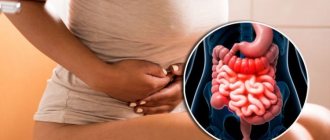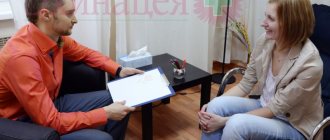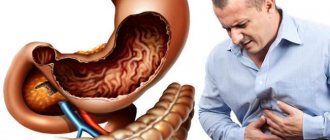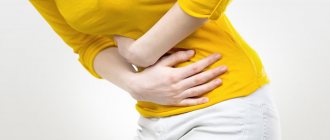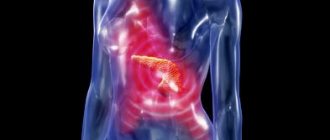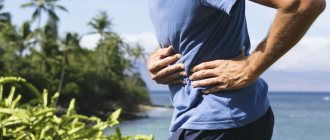Pain in the upper part of the stomach is a dangerous symptom that is a harbinger of many dangerous diseases. There are many reasons for this condition to occur. Unpleasant sensations can overtake you suddenly and pass quickly, or they can annoy you for a long time.
Despite the intensity and accompanying symptoms, any health problems must be addressed. Abdominal pain can be an indicator of various conditions, which we will discuss below.
Nature and duration of pain
Short-term pain (usually localized in the navel area on the right and left), which passes without taking painkillers, is often provoked by neurosis and is accompanied by diarrhea (diarrhea).
Urgent medical intervention is not required. However, if episodes occur repeatedly, it is worth making an appointment with a therapist. You may need to consult a neurologist. Acute pain in the abdomen on the right for the first time is a serious reason to seek medical help. Pain in the upper abdomen on the right may indicate biliary colic and peptic ulcer.
Violent (most intense) pain in the abdomen on the right side occurs when a stone moves along the ureter from the right kidney. An attack of renal colic is accompanied by vomiting, flatulence, frequent urge to urinate and the passage of a small amount of urine. In severe cases, blood pressure decreases and the patient loses consciousness. At the slightest suspicion of an attack of kidney stones, you should call an ambulance.
Severe tenderness in the lower abdomen on the right side is often associated with appendicitis. However, in the initial stage of inflammation of the appendix, the pain is aching (less intense when lying on the right side with bent legs), intensifies over time and radiates to the stomach and to the right of the navel. Subsequently, the pain increases, the abdomen becomes hard.
Cramping abdominal pain occurs with intestinal inflammation (including intestinal infections, such as salmonellosis) and poisoning. Pain is localized in the navel area, accompanied by nausea/vomiting, diarrhea, fever and intoxication (weakness, muscle pain, headache). In diseases of the colon (its ascending part, located on the right side), pain occurs during the movement of feces and is often accompanied by constipation/diarrhea and bloating.
Sharp pain in the right hypochondrium , intensifying with inspiration, is characteristic of right-sided pleurisy, which complicates the course of pneumonia. In this case, all the symptoms of lung damage are observed: fever, shortness of breath, cough.
People who lead a sedentary lifestyle often complain of throbbing pain at the navel on the right Unpleasant sensations are associated with blood stagnation and quickly pass after warming up. However, with constant pulsation in the abdomen, an abdominal aortic aneurysm cannot be ruled out.
If you experience acute abdominal pain, call emergency services!
A nagging, aching pain in the abdominal region on the right indicates chronic inflammation. Unpleasant sensations occur periodically or are permanent. In Crohn's disease, pain is often localized in the right iliac fossa (right, below) and mimics appendicitis.
Pyelonephritis is characterized by dull pain in the back, radiating down the abdomen, groin area and leg on the side of the affected kidney. In this case, the patient suffers from severe intoxication. With chronic inflammation, swelling appears in the legs; high a/d is difficult to reduce with conventional antihypertensive drugs.
Aching pain in the right hypochondrium after eating , nausea, heaviness and bursting sensations in the abdomen (in the upper part on the right side), lack of appetite are characteristic of chronic cholecystitis and liver inflammation. With hepatitis and cirrhosis, jaundice, dark urine, and discolored feces appear.
Pain may indicate cancer . However, in most cases, the initial stage of cancer is painless. The patient notes weight loss for no apparent reason, lack of appetite, perversion of taste, unstable stools (usually diarrhea), fragments of undigested food in the stool, jaundice (with liver cancer). Intense pain indicates the spread of the malignant process.
Clinical manifestations of hernia
In one of the above areas (navel, groin areas on the right or left, closer to the pubis, etc.) a subcutaneous protrusion appears, increasing with straining and disappearing when lying down. Usually the hernia is painless, has a soft-elastic consistency, and is freely reduced into the abdominal cavity. In doubtful cases, ultrasound can help. Sometimes patients experience pain in the hernia area associated with physical activity. The size of hernias is variable, from 2-3 cm to 10-15 cm. Having appeared, the hernia gradually increases in size.
Causes of abdominal pain on the right in women
Pain in the lower abdomen in women occurs before menstruation and is caused by contractions of the uterus. The discomfort goes away after 2-3 days. Often, on the 14th day from the start of menstruation during the period of ovulation (maturation and release of the egg into the uterine cavity), women complain of nagging pain or cramps in the lower abdomen on one side. In this case, there is slight bloating and an increase in vaginal discharge. The condition does not require medical intervention. If pain on one side (right or left) is not associated with menstrual bleeding, gynecological pathology should be excluded. In this case, the nature of the pain will help make a preliminary diagnosis.
- Acute pain - ectopic pregnancy, rupture of an ovarian cyst, adnexitis (inflammation of the appendages). The pain syndrome is often accompanied by bloody discharge, and the patient's condition rapidly deteriorates.
- Aching pain - fibroids, uterine flexion, endometriosis, corpus luteum cyst. The pain intensifies during sexual intercourse and is accompanied by pathological discharge from the vagina. If the intensity of the pain increases sharply and blood appears, you should urgently seek medical help.
Important! All women who complain of pain in the lower abdomen are referred to a gynecologist for consultation.
Pain in the right side may be associated with pregnancy - the growing uterus puts pressure on the abdominal organs. There is an unpleasant, throbbing pain, frequent urination, and heartburn. Fetal movements are often mistaken for pulsation. The first conscious movement is recorded at 18-20 weeks; before this period, fetal movements are usually not felt. Pain in the abdomen on the right and in the groin area during pregnancy is caused by the divergence of the pelvic bones. However, with severe abdominal pain on the right side in a pregnant woman, acute surgical pathology cannot be ruled out: cyst torsion, intestinal obstruction, abdominal aortic aneurysm.
Important! If there is pain in the lower abdomen on the right or left, warming procedures (using a heating pad) are strictly prohibited. This will only increase bleeding during menstruation, and in pregnant women it can cause a miscarriage. Expectant mothers should not take medications (painkillers, antispasmodics) without a doctor’s prescription. Many modern medications negatively affect the fetus and uterine tone.
Cramping pain in the abdomen after childbirth, which intensifies during breastfeeding, is a normal phenomenon caused by contractions of the uterus. However, due to overstretching of the ligamentous apparatus in the postpartum period, an umbilical hernia often forms. Protrusion of the abdominal wall is accompanied by painful sensations in the navel area on the right or left, bloating and rumbling in the abdomen.
Constipation can cause abdominal pain in women giving birth. Therefore, it is important to do squats after childbirth, in consultation with your doctor. Abdominal exercises will speed up uterine contractions, reduce blood loss and strengthen the abdominal wall.
Important! Taking laxatives is contraindicated for nursing mothers. This will lead to diarrhea in the baby. Prunes, oatmeal, fermented milk products and consuming 1 tbsp. will help improve defecation after childbirth. l. sunflower oil in the morning. Of the medications, the safest are glycerin suppositories.
The development of postpartum endometritis cannot be ruled out. After cesarean section, inflammation of the uterus occurs in 43% of cases. The disease is manifested by fever, purulent discharge and increased bleeding, pain in the lower abdomen and groin. The risk of disease is reduced by a prophylactic course of antibiotics.
Abdominal pain on the right side in men
Dull abdominal pain in men most often occurs due to an inguinal or umbilical hernia. The reason is excessive physical activity. A bulge in the groin often develops in boys under 1 year of age due to weakness of the ligamentous apparatus, so babies should not be allowed to cry angrily for a long time. Umbilical and inguinal hernias are eliminated with plastic surgery (suturing the hernia opening or strengthening it with a special mesh). Without timely surgical intervention, strangulation of the hernia is highly likely. The pain increases, spreads to the entire abdomen, patients note frequent vomiting, stool retention and bloating. The surgery is performed on an emergency basis.
Pain in the lower back, radiating to the groin and leg, is characteristic of protrusion and herniation of the intervertebral disc. Patients often complain of weakness and numbness in the legs. Once the diagnosis is confirmed, the doctor will prescribe an effective course of anti-inflammatory drugs. If necessary, a therapeutic blockade or surgery is performed.
Diseases of the genitourinary system in men (cystitis, prostatitis, prostate adenoma) are manifested by pain in the lower abdomen, which subsides after defecation and urination. However, sometimes the pain is worse on the right or left.
With orchitis (inflammation of the testicle) and vesiculitis (an inflammatory process that develops in the seminal vesicles), the temperature suddenly rises, a sharp or dull pain radiates to the groin and perineum, and intensifies when walking down the stairs and physical activity. The damaged testicle swells. Inflammation of the testicles often complicates the course of sexually transmitted diseases and is fraught with infertility.
Varicocele (varicose veins of the spermatic cord) is diagnosed in every fourth man under the age of 30. The disease is often asymptomatic and is diagnosed during clinical examination of adolescents. Only in severe cases does aching pain occur on one side of the scrotum and in the groin. Pain increases with overheating, physical exertion and during sexual intercourse.
When testicular torsion occurs, a sharp pain suddenly occurs in the scrotum on one side, radiating to the groin, perineum and lower back. In young boys, the disease is accompanied by nausea and vomiting. Palpation reveals a higher position of the testicle in the scrotum. The pathology is eliminated urgently.
Important! If you suspect prostatitis, prostate adenoma or testicular disease, you should contact a urologist-andrologist.
Causes of hernia
Hernias appear in the presence of predisposing and producing factors. Predisposing factors are: hereditary factor - defective development of connective tissue, anatomical features (for example, congenital enlargement of the umbilical ring).
Producing factors are factors that contribute to an increase in intra-abdominal pressure - physical activity (especially heavy lifting), chronic constipation, persistent cough, internal obesity, etc.
Once a hernia appears, it does not disappear on its own (with the exception of hernias in early childhood); it can only be eliminated through surgery.
Diagnostics
To make a diagnosis of abdominal pain on the right, the doctor prescribes the following tests.
Blood tests
A clinical blood test reveals signs of inflammation (increased leukocytes, accelerated ESR). Appendicitis is characterized by a sharp increase in the level of leukocytes to 15x109/l. Liver tests evaluate liver function.
Analysis of urine
A general analysis and, if necessary, urine culture exclude/confirm kidney inflammation and the presence of stones.
Stool tests
The coprogram diagnoses gastrointestinal diseases. If an intestinal infection is suspected, a stool culture is performed. A test for occult blood is prescribed when bleeding is suspected (for example, in Crohn's disease). Children who complain of abdominal pain are tested for dysbiosis and worm eggs.
Instrumental methods
Ultrasound (including Doppler mode) is the safest method for examining the abdominal cavity, pelvic organs and kidneys. The study is carried out for abdominal pain of any location in adults, pregnant women and children of all ages. If you suspect a disease of the stomach and gallbladder, it is advisable to undergo an FGDS. Pathology of the small intestine is diagnosed using x-rays. For colitis, colonoscopy is prescribed. However, the doctor receives the most accurate information about organic changes in the gastrointestinal tract using CT/MRI.
Complications of hernia
The most serious complication is strangulated hernia. It is characterized by the appearance of severe pain in the area of the hernia; the hernia ceases to be reduced into the abdominal cavity and becomes denser and more painful.
If you suspect strangulation, you must immediately call “03”, since if the operation is not performed within 2 hours, the strangulated organ (loop of intestine, omentum, etc.) may die, which will require a major difficult operation. You should not try to repair the hernia yourself; if done ineptly, this can cause serious complications.
Other complications include intestinal obstruction in the hernial sac, dysfunction of organs that are the contents of the hernia (for example, frequent urination when the bladder wall is involved in the inguinal hernia), compression of the spermatic cord, etc.
How to relieve pain at home
- If you experience abdominal pain on the right side for the first time, you should not take analgesics on your own. Anesthesia may distort the clinical picture and make diagnosis difficult.
- If there are signs of an “acute abdomen” (pain, board-shaped abdomen, vomiting, stool retention, fever), cold (a heating pad with ice on the epicenter of pain), hunger, rest (the patient should be placed in a comfortable position) and calling emergency help are recommended.
- If the patient cannot wait until the ambulance arrives, it is permissible to give an antispasmodic tablet.
When to see a doctor
In many cases, abdominal pain does not mean that the patient is sick with something. The pain may be caused by overeating, stress or emotional distress. In any case, a person wonders: why does it hurt? Here are symptoms that may indicate that you are sick:
- intense pain lasts continuously for more than six hours;
- the localization of pain is in the right part of the lower abdominal cavity;
- the peritoneum begins to hurt immediately after eating;
Treatment
Treatment tactics depend on the established diagnosis. Self-medication is fraught with deterioration in health and is sometimes associated with a risk to life. It is necessary to call an ambulance in several cases.
- Acute abdominal pain that does not go away within several hours.
- Within 1 hour after taking the antispasmodic, the pain does not stop or intensifies.
- Painful sensations are accompanied by fever, repeated/bloody vomiting, black feces or the presence of scarlet blood in the stool, and bleeding from the vagina.
- Pain in the abdomen develops against the background of a sharp deterioration in the patient’s condition.
- The abdomen has become hard (abdominal wall tension).
- Abdominal pain in a pregnant woman.
Make an appointment at the First Family Clinic of St. Petersburg if you are bothered by constant or recurrent abdominal pain of moderate intensity, in cases of deterioration or lack of therapeutic effect for a previously diagnosed disease.
Treatment tactics for abdominal pain on the right
- Gastrointestinal diseases - antispasmodics, antacids and antiulcer drugs, laxatives (for constipation), anti-inflammatory drugs and antibiotics (for inflammation, intestinal infections).
- Urogenital pathology and kidney diseases - antibacterial therapy, often requiring IV infusions to eliminate intoxication.
- Acute surgical pathology (appendicitis, ectopic pregnancy, intestinal obstruction) is an urgent operation.
The best solution, even if you have minor abdominal pain and no other symptoms, is to make an appointment with your doctor. Timely medical care will prevent the pathological process from worsening and often allows surgery to be avoided. Therapists, gastroenterologists and other specialized specialists at the First Family Clinic of St. Petersburg will prescribe only the necessary tests, quickly determine the exact cause of the pain and prescribe effective treatment. For a quick recovery, follow your doctor’s recommendations on the dosage and duration of taking medications, diet, and adhere to a healthy work and rest schedule.
Hernia treatment
Treatment for hernia is surgical only. Currently, there are various modifications of operations - plastic surgery with local tissues, surgery with the installation of a polypropylene mesh , laparoscopic surgery.
What kind of operation to perform depends on the specific situation, the issue is decided individually. All methods have their advantages and disadvantages.
Before surgery, patients are advised to avoid heavy lifting (no more than 5 kg), prevent constipation, and eliminate other factors that contribute to increased intra-abdominal pressure.
Recovery after surgery is quite fast. Stay in the hospital for up to 7 days; for small uncomplicated hernias, surgery in the hospital for one day is possible, local anesthesia, intravenous potentiation is possible, for laparoscopic surgery - only anesthesia.
After discharge, the patient remains on sick leave for an average of another 10–14 days, then begins work. It is recommended to limit physical activity (lifting weights up to 5 kg) from 2 to 5 months after surgery (depending on the method of surgery). If work activity involves lifting heavy objects, the patient is temporarily transferred to light work.
After surgery there are usually no problems. In rare cases, there is long-term pain in the area of the operation - neuralgia. Sometimes a relapse occurs - the reappearance of a hernia (this happens both due to technical errors in the operation, and when the patient violates the restrictions of lifting heavy objects). During mesh operations, serous fluid sometimes accumulates under the skin, which may require puncture.
